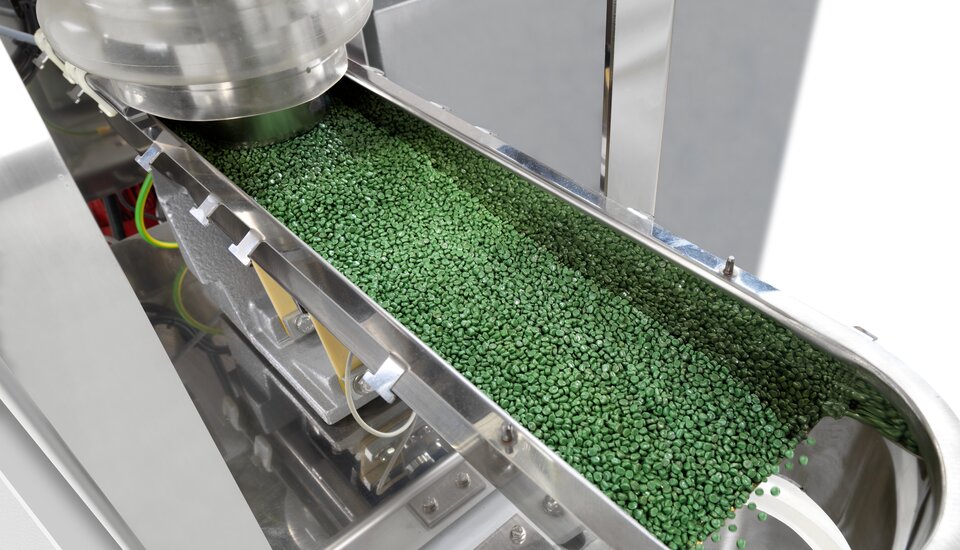
Sustainability
"The trend is clearly towards sustainability"
| Petra Rehmet
Experts Interview with Michael Schreyer and Thomas Strecker
Pail, box or waste container – for large packaging and logistics solutions, there is ever greater demand for sustainable solutions with which resources such as material and energy are used sparingly. The use of recycled material also plays an increasingly important role. In this interview with ahead, Michael Schreyer, Application Owner Packaging & Logistics, and Thomas Strecker, Head of Global Expert Sales Packaging & Logistics Industry, report on the potential and highlight solutions along the value chain.
ahead
In the field of logistics, it is above all about transport containers or even pails with a large capacity. What are the factors here that you can tweak to make production efficient and resource-conserving?
Michael Schreyer
With our GX series – which we recently expanded to include a clamping force of 13,000 kN – we offer our customers an optimum solution for efficient production. The advantage of the 2-platen technology is the flexibility when producing various pails and boxes – more specifically, the flexibility of the mold technology required for it. Large opening strokes, which are required for IML (in-mold labeling) applications, for example, can thus be implemented on units with very compact structural dimensions.
Thomas Strecker
Both the use of recycled materials and the general stress caused by high material throughputs, as is common with the applications mentioned, require a high-performance and robust plasticizing unit. The barrier screws (High-Performance Screw) from KraussMaffei are ideally suited for efficient continuous operation and at the same time deliver the best melt quality thanks to their high plasticizing capacity and the matching L/D ratio.
ahead
What other possibilities are there for saving resources?
Thomas Strecker
With regard to a functional circular economy, it is advisable in the IML process that containers and labels be made of the same material. This ensures that the products can be reused later as recycled material with minimal complications. Low energy consumption, for example, is one way to help ensure that resource efficiency is achieved.
With our smart BluePower drive concepts, we ensure an energy balance that is optimal for the respective application and process. For parallel movements, for example, the full performance range is available, but the intelligent servo technology ensures that energy is only consumed when it is called up by the respective consumer.

Thomas Strecker
Head of Global Expert Sales Packaging & Logistics Industry
ahead
Let us now turn to the larger logistics articles, pallets and large containers such as waste containers. These are becoming ever more important in transportation and in urban areas. Why is that?
Michael Schreyer
Plastic pallets are increasingly replacing conventional wooden pallets. They score well above all on account of the more individual design possibilities, and they can, for example, thus meet special requirements with regard to hygiene and food. In the waste container sector, we expect a growing demand for very large waste containers due to urbanization, such as 1100-liter bins for multi-apartment buildings. But the increasing separation of waste (non-recyclable waste, biowaste, paper or packaging) is also creating greater global demand for waste containers.
ahead
Is there potential for saving resources here, too? What about the use of recycled materials?
Thomas Strecker
When producing these articles, high material throughputs and high machine capacities are required due to the high shot weights. Therefore, the efficient processing of recycled material absolutely plays an important part in this sector. For the production of such large containers and pallets, the MX series from KraussMaffei already has numerous reference machines on the market with clamping forces from 16,000 kN to more than 60,000 kN. Thanks to our robust machine technology and high-performance large-volume injection concepts, the numerous systems have been operating efficiently for several years.
Many customers are already using a large proportion of recycled material. Compared to new material, however, recycled materials often still exhibit fluctuations in quality or composition. The APC plus (Adaptive Process Control) machine function helps keep the injection molding process constant, and thus always ensures high component quality. We like to compare the function to cruise control in a car.

Michael Schreyer
Application Owner Packaging & Logistics
ahead
How can the advantages of new and recycled material be feasibly combined here?
Michael Schreyer
Another example of the sustainable use of recycled material in combination with new material is so-called sandwich technology, i.e. a double-injection concept, which is used in the USA, for example. This makes it possible to use the advantages of new material (paint, UV protection, etc.) for the exterior wall, while at the same time using inexpensive recycled material as filler for the core.
ahead
What is the situation with regard to alternative, sustainable materials – does it make sense to consider the use of biodegradable plastics for logistics products?
Thomas Strecker
Since the logistics products are usually multi-use articles that are utilized for a longer period anyway and lend themselves very well to subsequent reuse for the production of new articles, we don't see much demand here. However, I think it makes more sense to think about this in the area of thin-walled packaging.
ahead
So the greatest potential lies in the use of recycled materials. For large logistics applications, use of even 100 per cent recycled material is possible. Where is the greatest obstacle at present for the exploitation of the whole range?
Michael Schreyer
The current obstacle is presumably the insufficient availability of suitable recycled material as well as the price/performance ratio compared to new material. Also, products such as garbage cans, pallets or transport crates often have to meet stringent requirements in terms of stability, color, UV resistance and even hygiene regulations, which can only be achieved with certain material compositions.
Thomas Strecker
However, the majority of products can already be manufactured with a high proportion of recycled material. The fact that many of our customers have their products certified with environmental labels such as the "Blue Angel" shows a clear trend towards a circular economy, resource conservation, and thus greater sustainability. Only products made of at least 80% recycled material receive the seal of the German Environment Agency. Last but not least, there is also growing social acceptance of, and perhaps even demand for, more products made from recycled material.
ahead
Thank you very much for these exciting insights and the further possibilities for more sustainability in packaging and logistics.
Kontakt
Thomas.Strecker@kraussmaffei.com


















